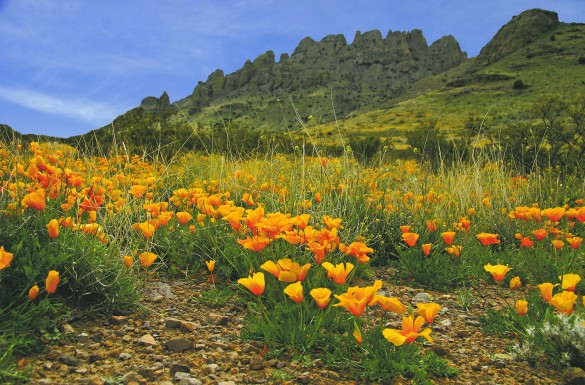Rockhound State Park
Kids Can Take Home What They Dig Up at Southern NM Park
Rockhound State Park
November 23, 2022By TANIA SOUSSAN

Kids who visit Rockhound State Park might have to unlearn the usual lesson that state and national parks are places where you can take only pictures.
“We’re one of only two state parks in the United States where you can take something,” said Manager Robert Apodaca. “That’s a very unique opportunity.” (The other is Crater of Diamonds State Park in Arkansas: arkansasstateparks.com/parks/crater-diamonds-state-park)
Visitors are encouraged to put a rock or two in their pockets as a souvenir from the park’s rocks and minerals. The most common is jasper, but rockhounds also find geodes and thunder eggs, pearlite and quartz, Apodaca said.
Onyx, agate, crystalline rhyolite (which looks like petrified wood) and obsidian also are among the common rocks and minerals found in the park, according to the New Mexico Bureau of Geology and Mineral Resources.
Set in the rugged, steep slopes of the Big and Little Florida Mountains near Deming, the southern New Mexico park is popular with campers and day-trippers. The intense summer heat makes spring and fall more comfortable times to visit.
Because of COVID-19 restrictions, Rockhound has been open for day use only and only to New Mexico residents. Hours have been 7 am to 4 pm Thursday through Sunday in the main unit of the park and 8 am to 4 pm daily in the nearby Spring Canyon unit. The visitor center has been closed. Check with the park for current conditions.
“I love the park. It’s beautiful place,” said Sally Allen, president of Friends of Rockhound State Park.
In addition to rock collecting, the park offers four trails, a labyrinth to walk, a native plant garden and bird watching. Once restrictions ease, visitors can enjoy stunning sunsets, magnificent night skies, a peaceful campground and a range of programs.
Just two miles south of the main unit of the park in the Big Florida Mountains is Spring Canyon.
“There are some beautiful, scenic trails,” Apodaca said.

The 1.5-mile round trip Spring Canyon Trail takes hikers to an ephemeral stream that flows for 100 to 150 feet after precipitation but is reduced to residual moss in drier times. The more intense 1.8-mile round trip Lovers Leap Trail switchbacks from 5,200 feet to 6,000 feet, Apodaca said.
Spring Canyon is a popular area for birding and the best spot to look for Persian ibex, mountain goats from Iran that were introduced to the park in the 1970s. They can be seen on the hillsides.
“They’re all around,” said Allen who recommends listening for falling rock and then scanning the hills with binoculars for the best chance to see one, particularly at dawn or dusk when they are most active.
Other wildlife includes coatimundis, deer, antelope, mountain lions, snakes and many species of birds as well as small mammals such as prairie dogs, rabbits and badgers. A variety of cactus and other plants also thrive in the arid environment.
But the prime attraction is the rocks, and the best place to look for them is in the main unit of the park. Many people start out from the visitor center on the half-mile Jasper Trail. It intersects with the Thunder Egg Trail, which follows the slope of the Little Floridas for about a mile and is the best place to search for rocks.
Allen said the geodes are “just the coolest things” and her favorite finds.
Digging geodes out of the hillside is tough but rewarding, according to Ruta Vaskys and Martin Freed, authors of “Rockhounding New Mexico: A Guide to 140 of the State’s Best Rockhounding Sites.”
“The interiors are beautiful,” they write. “Many have hollow centers with quartz and/or calcite or other species of crystals surrounded by agate. Even the solid nodules have beautiful agate interiors.”
Geodes are hollow or near-hollow with crystal-lined cavities and are found in igneous and sedimentary rocks, while thundereggs are solid or near-solid nodules formed by magmatic and volcanic processes, according to the Bureau of Geology and Mineral Resources.
You can’t tell which you’ve got until you break open the hard, rough-textured outer shell to reveal the beauty locked inside.
Although the park has been open since 1966, there still are treasures to be found.
“Jasper is very plentiful. If you turn your head, you’ll trip over one,” Apodaca said. Jasper can be tan, red, bronze or yellow.
Washes and ravines off the trails are among the best places to look, especially after a good rain, because erosion exposes the minerals, he said.
There are two ways to go about finding treasures once you’ve picked a spot to look – digging and simply looking on the surface. Taking along a hammer and chisel is a good idea, but no tools over 12 inches are allowed at Rockhound.
Rangers on duty and park volunteers are practicing social distancing and limiting interactions with the public, but they can answer questions about rocks that visitors find.
For more information visit emnrd.state.nm.us/SPD.

